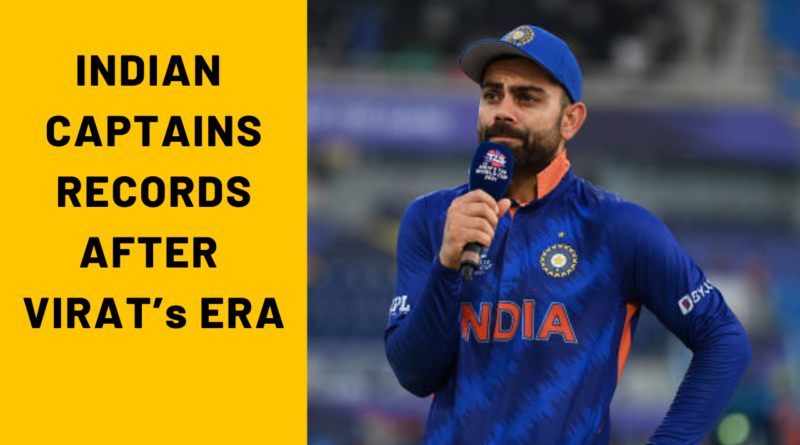Players who became Indian Captain after the end of Virat’s Era in 2021
Virat Kohli’s captaincy career spanned from 2014 to 2022, during which he led the Indian cricket team across all formats. He announced his decision to step down as India’s T20I captain after the T20 World Cup in 2021, and his tenure as ODI captain ended soon after. His last series as Test captain was against South Africa in 2022, where India lost the three-match series 2-1 despite winning the first Test.
In Test cricket, Virat Kohli captained India in 68 matches, the most by any Indian captain. He secured 40 wins, 16 losses, and 2 draws, with a win percentage of 58.82%. Kohli’s aggressive and successful leadership in Test cricket is highlighted by several records. He scored 5703 runs as captain at an average of 55.36, including 20 centuries and 7 double centuries. His success as a Test captain surpasses that of MS Dhoni, who won 27 out of 60 matches.
Virat Kohli Stats as Indian Captain:
| Format | Span | Matches | Won | Lost | Tied | No Result | Win % |
|---|---|---|---|---|---|---|---|
| Tests | 2014–2022 | 68 | 40 | 16 | 0 | 2 | 58.82% |
| ODIs | 2014–2021 | 95 | 65 | 27 | 1 | 2 | 68.42% |
| T20Is | 2017–2021 | 50 | 30 | 16 | 0 | 4 | 64.58% |
In ODIs, Kohli captained India in 95 matches, winning 65, losing 27, and having 3 matches end in a tie or no result, giving him a win percentage of 68.42%. He scored 5549 runs as captain, with an impressive average of 72.65, and 21 centuries. Kohli’s leadership in ODIs made him the fourth most successful Indian captain in this format, behind MS Dhoni, Sourav Ganguly, and Mohammad Azharuddin.
Kohli’s T20I captaincy record includes 50 matches, of which India won 30 and lost 16, with a win percentage of 64.58%. He scored 1570 runs as captain, making him the highest run-scorer among Indian T20I captains. Kohli is the only Indian captain to win the T20I series in SENA countries, achieving notable series victories in New Zealand, Australia, England, and South Africa.
Now let’s look into the stats of Indian captains after Virat Kohli
Indian Captains in Tests
| Name | Span | Matches | Won | Lost | Tied | Win % |
|---|---|---|---|---|---|---|
| Ajinkya Rahane | 2021 | 1 | 0 | 0 | 1 | Nil |
| KL Rahul | 2021-2022 | 3 | 2 | 1 | 0 | 66.67% |
| Rohit Sharma | 2022-Present | 16 | 10 | 4 | 2 | 62.50% |
| Jasprit Bumrah | 2022 | 1 | 0 | 1 | 0 | 0.00% |
Indian Captains in ODIs
| Name | Span | Matches | Won | Lost | Tied | NR | Win % |
|---|---|---|---|---|---|---|---|
| KL Rahul | 2022–23 | 12 | 8 | 4 | 0 | 0 | 66.67% |
| Rohit Sharma | 2022–present | 37 | 26 | 9 | 1 | 1 | 70.27% |
| Shikhar Dhawan | 2021–22 | 12 | 7 | 3 | 0 | 2 | 58.33% |
| Hardik Pandya | 2023 | 3 | 2 | 1 | 0 | 0 | 66.67% |
Indian Captains in T20Is
| Name | Span | Matches | Won | Lost | Draws/Ties | NR | Win % |
|---|---|---|---|---|---|---|---|
| KL Rahul | 2022 | 1 | 1 | 0 | 0 | 0 | 100.00% |
| Rohit Sharma | 2021–2024 | 43 | 34 | 8 | 1 | 1 | 79.06% |
| Jasprit Bumrah | 2023 | 2 | 2 | 0 | 0 | 0 | 100.00% |
| Shikhar Dhawan | 2021 | 3 | 1 | 2 | 0 | 0 | 33.33% |
| Rishabh Pant | 2022 | 5 | 2 | 2 | 0 | 1 | 50.00% |
| Hardik Pandya | 2022-2023 | 16 | 10 | 5 | 1 | 0 | 65.52% |
| Ruturaj Gaikwad | 2023 | 3 | 2 | 0 | 0 | 1 | 66.67% |
| Suryakumar Yadav | 2023-present | 10 | 7 | 2 | 1 | 0 | 70.00% |
| Shubman Gill | 2024 | 5 | 4 | 1 | 0 | 0 | 80.00% |
The stats indicate that the selectors experimented significantly with the captaincy after Virat Kohli stepped down.
Reasons behind the variety in Indian Captaincy:
Firstly, workload management played a crucial role. With the hectic schedule of international cricket, prioritizing the formats for ICC tournaments and managing the workload of key players became imperative. Rotating captains helped ensure players could rest and avoid burnout, thereby maintaining their performance levels. Injuries also contributed to the frequent captaincy changes. The unavailability of Rohit Sharma and Injuries to key players like Hardik Pandya necessitated temporary captaincy assignments to others, ensuring the team remained competitive despite the absences.
Additionally, the BCCI aimed to groom future leaders by providing various players with leadership opportunities. This strategy helped in identifying potential long-term captains who could take charge in the future. The selectors also considered format-specific leadership needs. Different players were identified as more suitable for specific formats. For example, Rohit Sharma was seen as a strong leader in both ODIs and T20Is, while others like Ajinkya Rahane and KL Rahul were given opportunities in Tests and ODIs.
The COVID-19 pandemic further complicated matters, leading to frequent schedule changes, player unavailability due to health protocols, and the need to field different squads simultaneously. This situation required flexibility in leadership roles to adapt to the evolving circumstances. Lastly, performance and strategic needs influenced captaincy decisions. The team management chose different captains based on performance and the specific requirements of various series or tournaments, ensuring that the team was well-prepared for each challenge.



